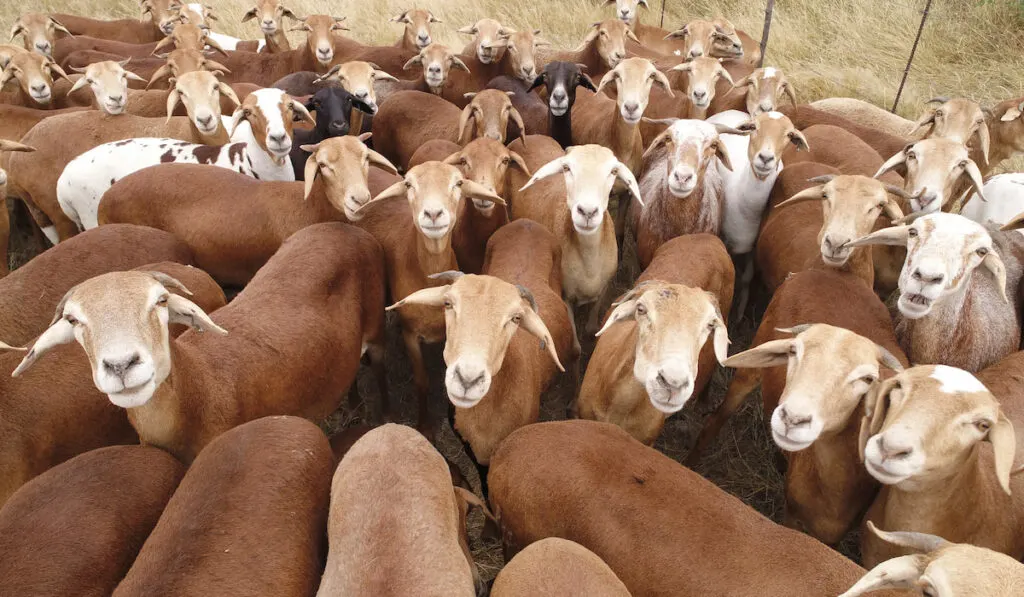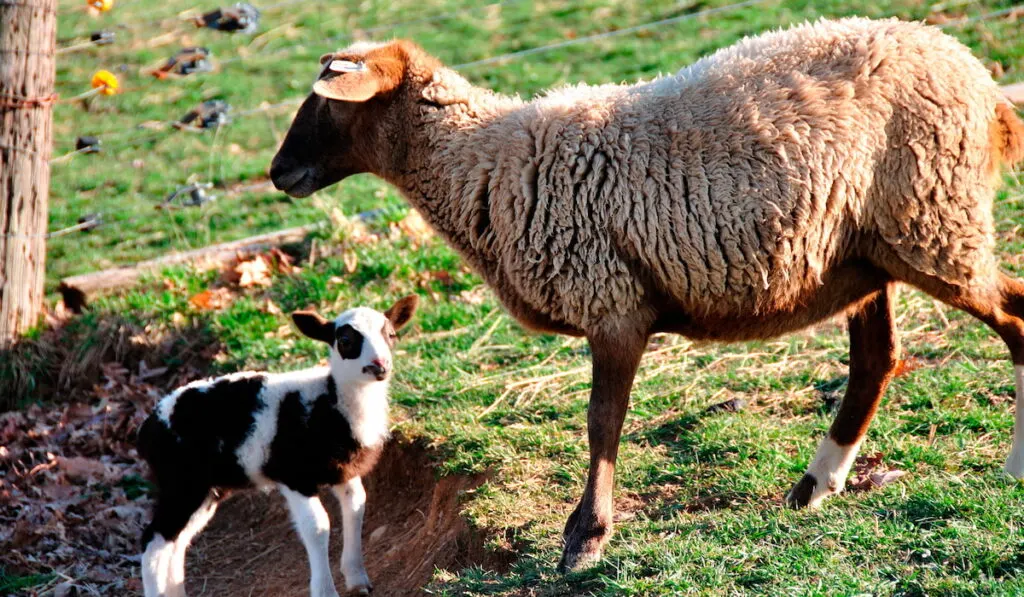Sometimes, it is hard to tell a sheep apart from a goat. This not too surprising since both animals belong to the same subfamily. Both animals are ungulate, ruminant animals.
They also have similar gestation periods – about 5 months. Sometimes, they even mate to produce offspring, which are usually infertile.
Nonetheless, they do have some marked differences, one of which is the number of chromosomes they have. While sheep have 54 chromosomes, goats have 60. Also, goats typically grow hair, while sheep may grow hair or wool.
Under normal circumstances, a goat’s tail is usually held upright. In contrast, the tail of a sheep typically droops and is short.
There are many more differences between sheep and goats. But in this article, we focus on some breeds of sheep that look like goats.
1. Damara

The Damara sheep is thought to have its origins in Egypt and the Hamites of East Asia before it moved towards Angola and Namibia.
At birth and when young, Damara sheep are wooly, and they have long hair. But as they grow older, they lose most of the wool.
Ultimately, their coat is predominantly hair. This is one of the reasons why they look like goats.
Damara sheep are pretty hardy. The ewes have an exceptional maternal drive and a relatively high fertility rate.
Damara rams usually have spiral horns. But the ewes are typically polled. While the ewes appear feminine, the rams are sturdier and robust.
2. Djallonke
The Djallonke sheep breed is also known as the Cameroon sheep or West African dwarf. As its aliases reveal, this breed originated in West Africa.
It can now be found in various countries, including Cameroon, Ivory Coast, Ghana, southwest Nigeria, Benin, southern Senegal, and many others.
The Djallonke is a hair-type sheep. So, it is not too surprising that it looks like a goat. It is typically small-sized and thin-tailed, with a dense, tight coat.
Djallonke sheep are bred for their meat. The rams typically weigh an average of 82 pounds. On the other hand, the ewes have an average weight of 55 pounds.
The rams have crescent-shaped horns and a ruff on their chest and neck. The ewes are typically polled, but they may have short, slender horns.
3. Nellore
The Nellore sheep breed can be found in Ongole, Prakasam, and Nellore districts in Andhra Pradesh, India. Like the other breeds we have discussed so far, it is a hair-type sheep.
Nellore sheep are typically bred for meat. They come in 3 coat colors: white, piebald, and brown. On average, Nellore rams weigh 88-99 pounds, and they have horns.
The ewes are usually hornless, and they weigh an average of 66-77 pounds. At birth, Nellore lambs around 5-7 pounds.
Nellore rams can be as tall as 36 to 40 inches when mature. The ewes can grow to 30 to 34 inches as adults.
4. Africana
The name of this breed might be Africana, but ironically, it is found in Venezuela and Colombia. Africana sheep go by many other names, including Pelona, West African sheep, Camura, and Rojo Africana.
This breed typically comes with coats in various shades of red or brown. Both rams and ewes are polled, and sometimes the rams have manes. Africana sheep are typically reared for meat.
Africana sheep are a hair breed, bearing much resemblance to the Pelibuey breed.
5. Meatmaster Sheep
The Meatmaster breed is another hair breed.
It is a fat-tail sheep created by crossing the Damara and any other breed – most commonly Dorper.
Depending on their crossing, there are three Meatmaster variants: the all-rounder, the all-rounder African, and the all-rounder European.
The all-rounder African bears more semblance to a purebred Damara. The all-rounder European is crossed from Damara and Dorper. The straight all-rounder variant has most of the typical features of the Meatmaster breed.

Meatmaster sheep are pretty tough and hardy. They are bred solely for their meat and are a fertile breed.
6. Morada Nova Sheep
Morada Nova is a sheep breed of Brazilian origin.
It is thought that the breed may also have some African origin and Portuguese linkage. Both sexes of the Morada Nova breed are polled and woolless, but the rams may have scurs.
Morada Nova sheep are bred for two chief purposes: meat and hide. On average, they weigh 66 to 88 lbs. The ewes generally weigh less than the rams. Morada Nova sheep are hardy, and they come in red or white coats.
7. Pelibuey Sheep
As we said earlier, the Pelibuey sheep and the Africana bear a lot of semblances. But while the Africana is found in Colombia and Venezuela, Pelibuey is mainly found in Cuba. It may also be found in coastal Mexico and some other parts of the Caribbean.
The Pelibuey breed is a hair breed – they do not grow wool. Their coats come in various colors, including red, brown, beige, black, white, and roan.
Pelibuey rams do not typically have horns. However, they have ruffs. The ewes are usually hornless. Generally, Pelibuey sheep are bred for meat. They are a small breed typically weighing 75 to 119 pounds.
8. Barbados Blackbelly
The Barbados Blackbelly is a native breed of the Caribbean Island of Barbados. However, it has some West African ancestry.
Sheep of this breed are pretty hardy – they can adapt to various environments. They are also reproductively efficient. Barbados Blackbelly sheep birth two lambs at a time and have a lambing interval of 8-9 months.
Barbados Blackbelly sheep typically grow medium to thick hair with no wool. But those in colder regions may develop wool undercoats to withstand the extreme temperature.

Every year they shed their hair (and wool, if applicable). The coats of a Barbados Blackbelly come in all shades of brown, yellow, or tan. Like their name says, their belly and underparts are black.
Barbados Blackbelly ewes and rams are typically polled. Alternatively, they may have scurs or tiny horns.
9. Painted Desert
Painted Desert sheep were considered multi-colored Corsicans before. But there were later classified as a separate breed.
The Painted Desert might seem woolless, but it is not. Instead, it has a double coat – the slick, glossy hair coat and its short winter wool.
When spring comes, it casts the winter wool, leaving the glossy hair coat. So, if you come across the Painted Desert sheep in spring, you might think it is woolless.
The coats of a Painted Desert are sometimes intricately colored. In some cases, the coat features a combination of up to 4-5 colors.
Beyond their fine coats, Painted Desert rams have horns of various shapes, a feature that makes them coveted by hunters. Some ewes may have horns too.
The Painted Desert is a medium to large breed. The average weight of the rams is around 75 to 200 pounds. The ewes average 60 to 120 pounds with heights of up to 21 to 25 inches. The rams can be as tall as 30 inches.
Painted Desert sheep breed out of season. They lamb two times a year with a lambing interval of 6 to 8 months.
Resources
- https://sciencing.com/similarities-goats-sheep
- http://www.sheep101.info/sheepandgoats.html
- https://www.livestockoftheworld.com/sheep/
- http://afs.okstate.edu/breeds/sheep/damara/
- https://www.livestockoftheworld.com/sheep/Breeds
- https://ornamental-breeders.org/djallonk%C3%A9-sheep-breed-standard
- https://www.livestockoftheworld.com/sheep/Breeds.
- http://afs.okstate.edu/breeds/sheep/nellore/
- http://www.agritech.tnau.ac.in/expert_system/sheepgoat/breeds.html
- http://afs.okstate.edu/breeds/sheep/africana/
- https://www.farmersweekly.co.za/animals/sheep-goats/meatmasters-bred-for-tough-conditions-and-good-meat/
- https://www.roysfarm.com/morada-nova-sheep/
- https://www.roysfarm.com/pelibuey-sheep/
- https://www.livestockoftheworld.com/sheep/Breeds.
- http://afs.okstate.edu/breeds/sheep/barbadosblackbelly/
- https://www.livestockoftheworld.com/sheep/Breeds
- https://tejasbarbadoranch.tripod.com/id44.html
